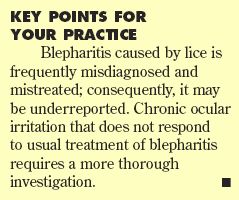Woman With Lousy Eyelashes
For several months, a 45-year-old woman had ocular irritation, tearing, blurred vision, and swelling of the eyelids in both eyes. During that time, she had been treated for allergic conjunctivitis and blepharitis by several physicians, including an ophthalmologist. Her medical history included lupus and seasonal allergies, for which she was taking hydroxychloroquine and loratadine.
For several months, a 45-year-old woman had ocular irritation, tearing, blurred vision, and swelling of the eyelids in both eyes. During that time, she had been treated for allergic conjunctivitis and blepharitis by several physicians, including an ophthalmologist. Her medical history included lupus and seasonal allergies, for which she was taking hydroxychloroquine and loratadine.

The patient’s best corrected visual acuity was 20/25 in the right eye and 20/20 in the left eye. Intraocular pressures were within normal limits. Slit lamp examination revealed nits on the eyelashes (Figure 1), with associated inflammation of the eyelid margin and mild conjunctival injection in both eyes.

The patient was treated with pyrethrin application to the hair and body, with a second application 10 days later. Bacitracin ointment was generously applied to the eyelids to smother the lice, and a comb was used to manually remove the nits. No lice or nits were seen at 2-week follow-up.
LICE INFESTATION OF THE EYELASHES
Lice infestation is a rare cause of blepharitis. The species that most commonly infests human eyelashes is Pthirus pubis; infestation by Pediculus capitis is rare, and Pediculus corporis is almost never found on the eyelashes.1,2 Lice infestation is more prevalent in poor hygiene conditions. 3 The ectoparasite can be transferred from one person to another by hand transmission, the sharing of towels and clothing, and by sexual contact.2 Phthiriasis palpebrarum in a child suggests sexual abuse.

P pubis, the pubic louse (Figure 2), is smaller and more sedentary than head and body lice. It is sometimes called the crab louse because it has 3 sets of legs, 2 of which (the hind sets) have crablike claws, which tightly grip pubic hair and eyelashes.2
After infestation,, the female louse lays eggs covered in an adhesive substance that firmly attaches to the hair shaft. After about 1 week, the nits hatch. The immature louse develops into the adult stage and feeds on blood by secreting an anticoagulant in its saliva. The resultant bluish bite marks (maculae caeruleae) and redbrown feces of the lice may be seen.1,2
Clinical features. The immune response to the louse saliva and excretions consists of itching and irritation. Patients may complain of tearing, blurred vision, and eyelid edema. A bacterial superinfection can result if the bites are scratched.1,2 Conjunctival injection and keratitis are rare complications, which can cause preauricular lymphadenopathy.2,3
Evaluation. Diagnosis is generally made by slit lamp examination. The lice and nits can be easily missed because of their relative transparency, slow movement, and location-deep at the bases of the cilia. Microscopic examination of a removed louse can further confirm the diagnosis.
Be sure to examine the patient for other sites of infestation and obtain a full sexual history. About onethird of patients may have another sexually transmitted disease.3
Advise patients to clean clothes, bed sheets, and towels in 120°F water for a minimum of 30 minutes. Female patients should consider discarding their eye makeup.
Treatment of eyelash infestation. Application of an ointment, such as bacitracin, petroleum jelly, or yellow mercuric oxide, can suffocate adult lice. This should be continued for 2 weeks to smother lice from newly hatching nits.2 Physostigmine ointment, an anticholinesterase, is infrequently used because of systemic side affects. The nits can be removed manually with tweezers, a comb, cryotherapy, or argon laser or by trimming the eyelashes close to the lid margin.4 Follow-up in 2 weeks is warranted to ensure there is no reinfestation.

Treatment of other sites of infestation. Pyrethrin, a natural compound produced by certain plants, and permethrin, the synthetic form of the same compound, are commonly used as insect repellents and insecticides. The compound is applied to the affected area and washed off after 10 minutes. A fine-tooth comb is then used to remove the dead lice. A second application is done in 10 days. Pyrethrin and related compounds rarely cause adverse effects, other than local skin irritation, and are generally safe in children and pregnant or lactating women.
Lindane usually formulated in a shampoo or lotion is another option. Because adverse reactions can range from skin irritation to seizures, lindane is not recommended for use in children younger than 2 years, pregnant or lactating women, and in persons with seizure disorder.
References:
REFERENCES:
1.
Lin YC, Kao SC, Kau HC, et al. Phthiriasis palpebrarum: an unusual blepharoconjunctivitis.
Zhonghua Yi Xue Za Zhi (Taipei)
. 2002;65:498-500.
2.
Vandeweghe K, Zeyen P. Phthiriasis palpebrarum: 2 case reports.
Bull Soc Belge Ophtalmol.
2006; 300:27-33.
3.
Kanski JJ.
Clinical Ophthalmology: A Systematic Approach. 6th ed
. Edinburgh: Butterworth-Heinemann; 2007:131-132.
4.
Mansour AM. Photo essay: phthiriasis palpebrarum.
Arch Ophthalmol.
2000;118:1458-1459.